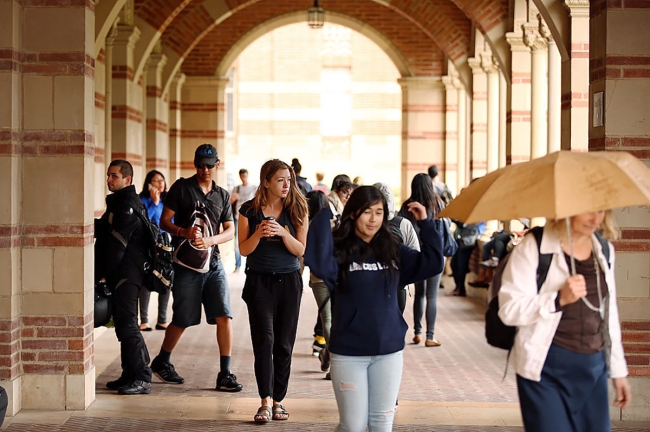You have /5 articles left.
Sign up for a free account or log in.

A recent law could make it easier for community college students to transfer to UCLA and the UC system as a whole.
Al Seib/Los Angeles Times/Getty Images
Governor Gavin Newsom recently signed legislation that creates a new transfer pathway to the University of California system, starting with the University of California, Los Angeles. The move is the result of a collaboration between state law makers and UC leaders and comes after substantial back-and-forth discussions between the two parties on how to best streamline the transfer process from two-year colleges to the university system.
Supporters of the law say it’s a valuable step forward, while critics say it’s a baby step at a time when larger reforms are needed.
Under the law, Assembly Bill 1291, the UC system is expected to launch a new Associate Degree for Transfer pilot program at UCLA in the 2026–27 academic year. The program will offer priority admission to students at certain community colleges who complete an associate degree for transfer, or an A.D.T., which guarantees admission to the California State University system, in select majors. The legislation also requires that transfer students who meet UC admissions criteria but don’t get into UCLA will be guaranteed admission to at least one other campus in the system.
The program will be open to students who earn A.D.T.s in at least eight majors and will expand to 12 majors by the 2028–29 academic year, with four of those majors in STEM fields. At that time, four additional UC campuses will be expected to join the program.
“By working together, California’s three world-leading higher education systems are ensuring more students have the freedom to thrive, learn, and succeed,” Newsom said in a press release after signing the legislation. “With this new law, the Golden State is streamlining the transfer process, making a four-year degree more affordable for transfer students, and helping students obtain high-paying and fulfilling careers.”
Dr. Michael Drake, president of the UC system, said in the release that system leaders look forward to continuing to work with Newsom, Assemblymember Kevin McCarty, who authored the legislation, and other state lawmakers to streamline the transfer process.
The law comes after multiple attempts by state lawmakers to push UC campuses to adopt new guaranteed transfer pathways. McCarty authored a more expansive bill earlier this year that called for the UC system to embrace the A.D.T. as its systemwide guaranteed transfer pathway so students can gain admission to the CSU and UC systems by fulfilling one set of requirements. The bill sparked opposition from the UC system—some system leaders and faculty members argued at the time that CSU major requirements differ too much from UC requirements and that students admitted through the shared guarantee might come to UC campuses unprepared and may have to take extra classes, costing them more tuition dollars and delaying their completion of college. Proponents insisted the move would simplify the transfer process and prevent students from having to navigate a maze of different requirements between the two systems.
Newsom also threatened in a January budget proposal that UCLA would lose a chunk of state funding if it didn’t create a guaranteed transfer pathway, though the demand didn’t make it into the final budget. UCLA would have been required to join the UC Transfer Admissions Guarantee program, which offers California community college students who meet campus-specific criteria guaranteed admission to participating UC campuses. Six of the nine campuses that serve undergraduates currently participate in the program; UCLA, UC Berkeley and UC San Diego are the exceptions. Some UCLA professors were taken aback by the singling out of the university by Newsom at the time.
But UC system leaders say they’re on board with and were thoroughly involved in the crafting of the most recent legislation. They’ve also recently created a program called Journey to the UC, a three-day trip to the Davis and Berkeley campuses for prospective transfer students attending 69 community colleges with low transfer rates to UC institutions. The goal is to make transfer feel more attainable to students at these institutions, which tend to be in lower-income and rural areas.
“UC has always been interested in making this pathway as smooth and accessible as possible,” said Katherine S. Newman, provost for the UC system, who noted that nearly a third of UC undergraduates transferred from California community colleges. “The concerns had to do with whether or not particular versions of those pathways would lead to the most diverse and equitable forms of access … But the level of cooperative relations between the governor’s office, the Legislature and the university is really at quite an extraordinarily positive state now, and I think that creates the trust and the vehicles by which our common goals can be realized.”
Newman said the pilot program is a way to “proceed carefully” and try out the model before expanding it. She added that UCLA was chosen as the initial site in part because it’s located near some of the community colleges that have lower rates of transfer to the UC system and including those kinds of institutions in the program is a “very high priority.”
Concerns about discrepancies between CSU guaranteed transfer requirements and UC major requirements haven’t entirely dissipated among UC professors.
Andrea Kasko, chair of the UCLA Academic Senate and a bioengineering professor, said committees of the Senate will be taking a close look at what majors at different community colleges earn students an A.D.T. and most closely align with UCLA majors. The hope is to “ensure that we’re improving access,” but at the same time “ensuring that the students are coming in prepared,” particularly for STEM majors.
She noted that the pilot program involves tracking completion rates and other outcomes. As a part of the legislation, the Legislative Analyst’s Office, a nonpartisan state government agency that advises lawmakers on policy, has to review the pilot program and submit reports on its progress in 2027 and 2030 to state lawmakers.
“We value accessibility to the UC system and to UCLA,” she said. The program could help community college students “get to the UC, in an easier way or a more transparent way,” but “we need to keep our eye on metrics like time to degree to make sure that this transfer process isn’t inadvertently pulling students down or costing them more.”
She added that A.D.T. requirements are “a different vehicle than we’re used to for transfers” that “were really designed for the CSU system and not for the UC system,” so it’ll take time and thought to figure out how to align the two.
Some students and their advocates say the legislation doesn’t go far enough.
The UC Student Association and the Student Senate for California Community Colleges opposed the bill in September. Student leaders said in their opposition statement that the bill didn’t involve student input and is too limited in scope. They also criticized the bill for not guaranteeing students admission to the CSU or UC campus of their choice.
“Transfer reforms must be grounded in the expertise and experience of practitioners, staff, and most importantly, students,” the statement read.
Jessie Ryan, executive vice president of the Campaign for College Opportunity, a California-based research and advocacy organization, said the pilot program has “potential for addressing a piece of the problem,” but it’s a “really a modest step towards simplifying transfer for community college students seeking to enter the UC.”
“AB 1291 is really the baseline and not the ceiling of what our expectation should be,” she said.
Ryan’s organization sponsored and advocated for the earlier legislation, which would have created a single guaranteed transfer pathway to both the CSU and UC systems. She still believes that broader policy shift is necessary to streamline an overcomplicated transfer process.
She noted that another law, signed by the governor in 2021, mandates that all California community college students be automatically placed on A.D.T. pathways by fall 2024. Transfer reforms will be “more urgent perhaps than ever before” to ensure that the growing number of students earning A.D.T.s get as much out of those degrees as possible.
She added that when the A.D.T. was established in 2010, companion legislation requested that the UC system develop a similar systemwide guaranteed pathway. The UCLA pilot program is now slated for a final review by the Legislative Analyst’s Office in 2030.
“Frankly, we think 20 years is too long for students to wait for necessary change,” Ryan said.
Newman said she empathizes with concerns about place-bound students who might gain automatic admission to a UC campus but not necessarily the one they wanted or one that’s geographically close.
“Low-income students are often responsible for helping their younger siblings, for contributing to the earnings of their households, and they don’t feel they can break away from those obligations just because they’re now college students,” she said. But because there are only nine undergraduate UC campuses across the state, compared to 116 community colleges, the reality is these campuses “aren’t everywhere” and many students don’t have a UC nearby regardless. The system uses financial aid and other supports to “make it as easy as possible for them to consider the UC opportunity.”
She said, “There is no other public university of the caliber of UC that is that transfer intensive,” but the transfer process is still a work in progress, and the pilot program is a part of finding ways to simplify it.
“We can always do more,” she said. “We can always do better, and we can always be more mindful of those constraints that students face and do everything we can to help them overcome them.”





